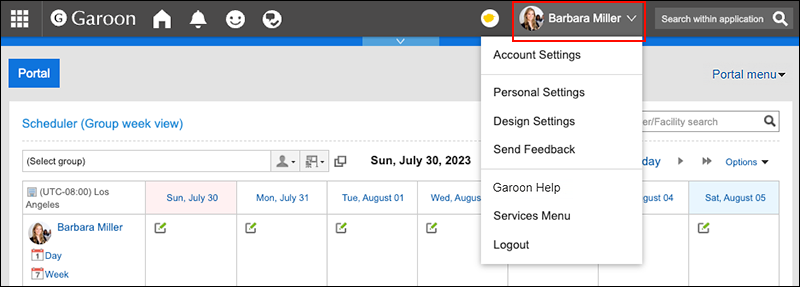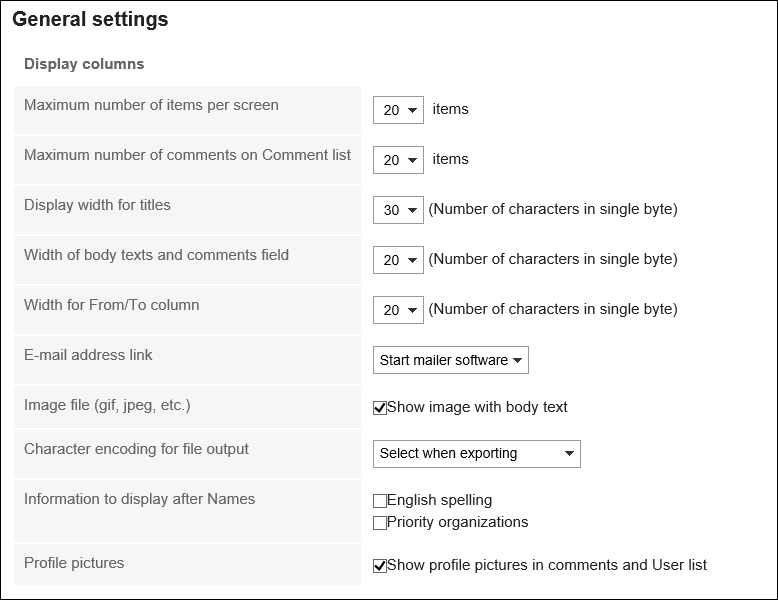Display fields and input fields
You can change and customize the configuration of screen related items, such as the number of items shown in Message and Bulletin Board or the width of the input field for the body text, to make them easier to use.
-
Click User name in the header.

-
Click Personal Settings.
-
On the "Personal settings (common)" screen, click Display fields and input fields under "Screen".
-
Configure items for the display columns.
For details on items to configure for the display columns, refer to Setting Fields in the Display Column.
-
Configure items for the input fields.
Configure the width of the input field for the body text of Messages and Bulletin Board.
- Width of input field for body:
Select the width of the input field for the body text, in the number of single byte characters.
This setting is not applied to the following fields.- E-mail body text
- Contents of HTML portlet (My portlet)
- Height of input field for body:
Select the height of the input field for the body text, in the number of rows.
This setting is not applied to the text body of e-mails.

- Width of input field for body:
-
Confirm your settings and click Save.
Setting Fields in the Display Column
This section describes the setting fields in the display columns.
- Number of items to be displayed on the list screen:
Configure the number of items to display on the list screen, such as in Messages, and Bulletin Boards.
- Maximum number of comments on Comment list:
Configure the number of comments to display on the details screen, such as in Messages and Bulletin Boards. - Display width for titles:
Configure the number of characters for the subjects to display on the list screen, such in Messages and Bulletin Boards. The number is the number of characters when inputting in single-byte characters.
This setting is not applicable for the "Notifications" portlet which uses "Multi-line layout".
- Width of body texts and comments field:
Configure the number of characters for body texts and comments to display on the list screen, such as in Messages and Bulletin Boards. The number is the number of characters when inputting in single-byte characters.
This setting is not applicable for the "Notifications" portlet which uses "Multi-line layout".
- Width for From/To column:
Configure the number of characters for the sender/recipient names to display on the list screen, such as in Messages and Bulletin Boards. The number is the number of characters when inputting in single-byte characters.
- E-mail address link:
Select the application or screen you want to start when you click the link of an e-mail address that is included in the body and comment.
Depending on the system administrator settings, the third-party software names may be displayed in the options.- Start mailer software:
The e-mail program is launched. - Start E-mail:
The "Compose E-mail" screen of Garoon is displayed.
- Start mailer software:
- Image files (gif, jpeg, etc.):
 When the "Show image with body text" checkbox is selected, the image files attached to messages and bulletin board are displayed with the body and comments.
When the "Show image with body text" checkbox is selected, the image files attached to messages and bulletin board are displayed with the body and comments.
You can display image files in the following formats.- gif
- jpeg
- pjpeg
- png
- Character encoding for file output:
Select a character encoding to use for exporting messages, bulletin boards, notes, or e-mails to a text file.
When you enable the "Select when exporting" setting, you can select a character encoding when you export files. - Information to display after Names:
Select the items displayed after user names. Depending on your system administrator's settings, the items you set may not appear.- English spelling:
Select to display the English name after the name of the user. Depending on your system administrator settings, you may not be able to select English names.
- Priority organizations:
Configure to display the priority organization name after the name of the user.
- English spelling:
- Profile pictures:
If you select the "Show profile pictures in comments and User list" checkbox, images that are registered in the user details are displayed as icons representing them.
Notes on User Name and English Name
When the English name is set to display, the user name is displayed in the following order.
- Display name in another language ("Display name" in basic information of users)

However, the name may be different depending on the language of the logged-in user and the language of the user name.
- Logged in user language: Japanese
Language to display user name Example of user name display 日本語 Daisuke Kato English Kato Daisuke 中文(简体) Kato Daisuke No settings Daisuke Kato - Login User language: English (US) or Chinese (Simplified)
Language to display user name Example of user name display 日本語 Daisuke Kato English Kato Daisuke 中文(简体) Kato Daisuke No settings Kato Daisuke - Login User language: According to the Web browser settings
This is similar to the language that is set in the language of the logged-in user.
If you have set a language that is not in the language of the logged-in user, "English (US)" is considered.
- Login User language: Japanese or English (US)
Language to display user name Example of user name display 日本語 Li Run Cheng English Li Run Cheng 中文(简体) Li 润 Ari No settings Li Run Cheng - Login User language: Chinese (Simplified)
Language to display user name Example of user name display 日本語 Li Run Cheng English Li Run Cheng 中文(简体) Li 润 Ari No settings Li 润 Ari - Login User language: According to the Web browser settings
This is similar to the language that is set in the language of the logged-in user.
If you have set a language that is not in the language of the logged-in user, "English (US)" is considered.